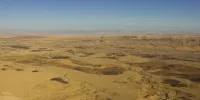Mount Sinai, also referred to as Mount Horeb, is significant in the Hebrew Bible, specifically the Book of Exodus. It is the location where Moses received the Ten Commandments from God. The event is a cornerstone of Jewish and Christian religious tradition, marking a pivotal moment of divine revelation and the establishment of a covenant between God and the Israelites. Sinai's precise geographical location remains debated, but its symbolic importance as the site of the giving of the Law is undisputed.
1950: Abandonment of Har Karkom
Around 1950 BCE, Har Karkom, a Paleolithic cult center, appears to have been abandoned. This location has been proposed as a possible location for the biblical Mount Sinai, though its timeline does not match most estimations.
1954: Construction of Greek Orthodox chapel
In 1954, the church at the peak of Jabal Musa was replaced by a Greek Orthodox chapel.
2000: Peak of religious activity at Har Karkom
Around 2000 BCE, the peak of religious activity occurred at Har Karkom, a Paleolithic cult center located in the southwest Negev desert in Israel.
2003: Identification of Hala-'l Badr as Mount Sinai
In 2003, Colin Humphreys, along with A. Musil and J. Koenig, advocated for the el Jaww basin volcano Hala-'l Badr as a possible location for Mount Sinai.
2012: I. Knohl's research on Mount Hermon as Mount Sinai
In 2012, I. Knohl's contested research suggested that Mount Hermon is actually the Mount Sinai mentioned in the Hebrew Bible, relating the biblical story to an ancient battle between northern tribes and Egyptians.
Trending
5 months ago Jalen Williams Shines in NBA Finals, Draws Michael Jordan Comparison.
14 days ago Thunder exercise options for Wallace and Topic, securing backcourt duo for future.
7 days ago Dodgers-Blue Jays World Series Game 4; Shrewsberry commits; Broncos Survey Released.

6 months ago OKC Thunder Awaits Luguentz Dort's Return to Peak Performance This Season
Collin Gillespie is a professional basketball player currently with the Phoenix Suns also playing for the Valley Suns in the...

5 months ago Hartenstein's career upgrade and Thunder's double-big lineup strategy in the NBA Finals.
Popular

Chuck Schumer is the senior United States Senator from New...

Gavin Newsom is an American politician and businessman currently serving...

Candace Owens is an American political commentator and author known...

XXXTentacion born Jahseh Dwayne Ricardo Onfroy was a controversial yet...

William Franklin Graham III commonly known as Franklin Graham is...
Turning Point USA TPUSA is an American nonprofit organization founded...
